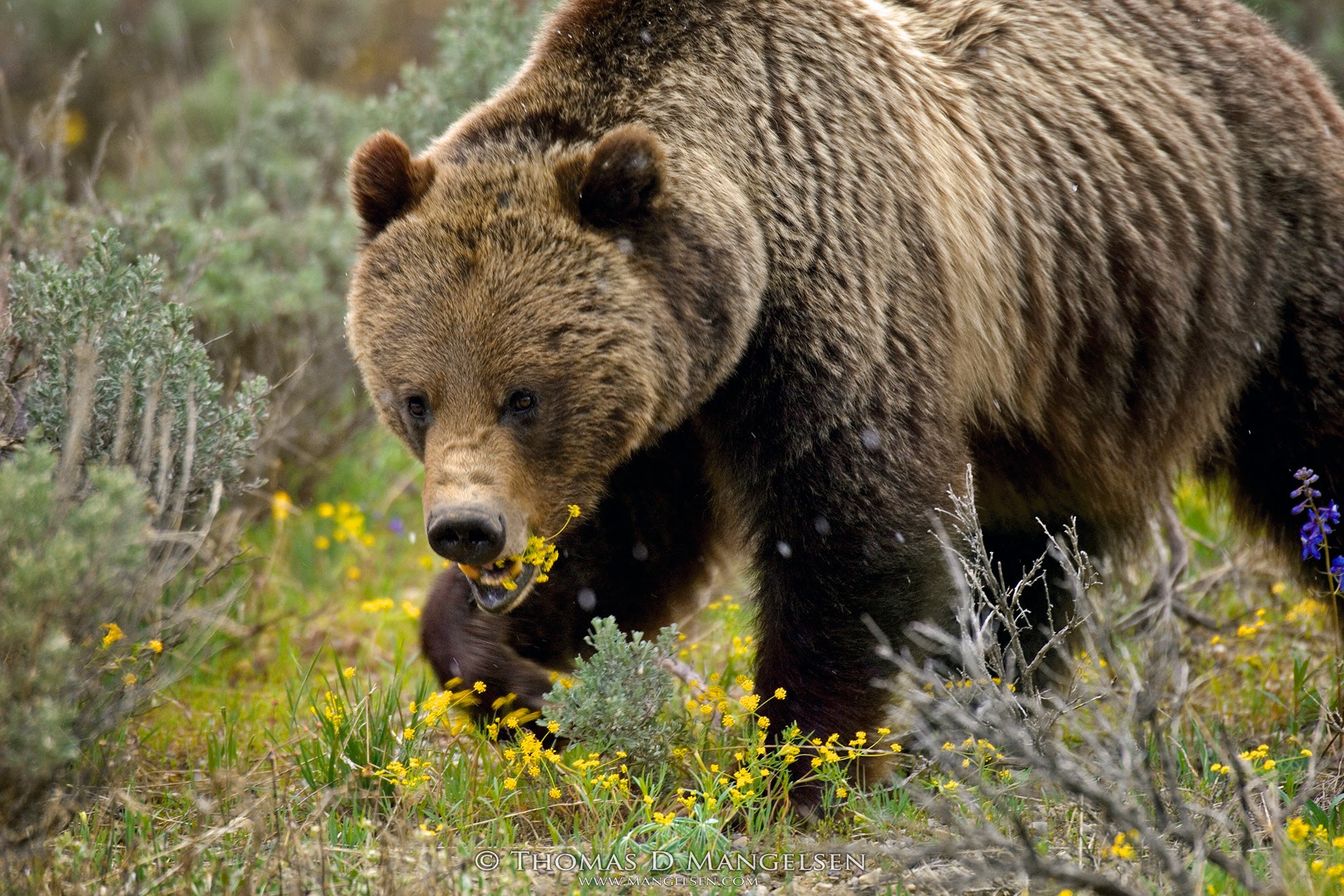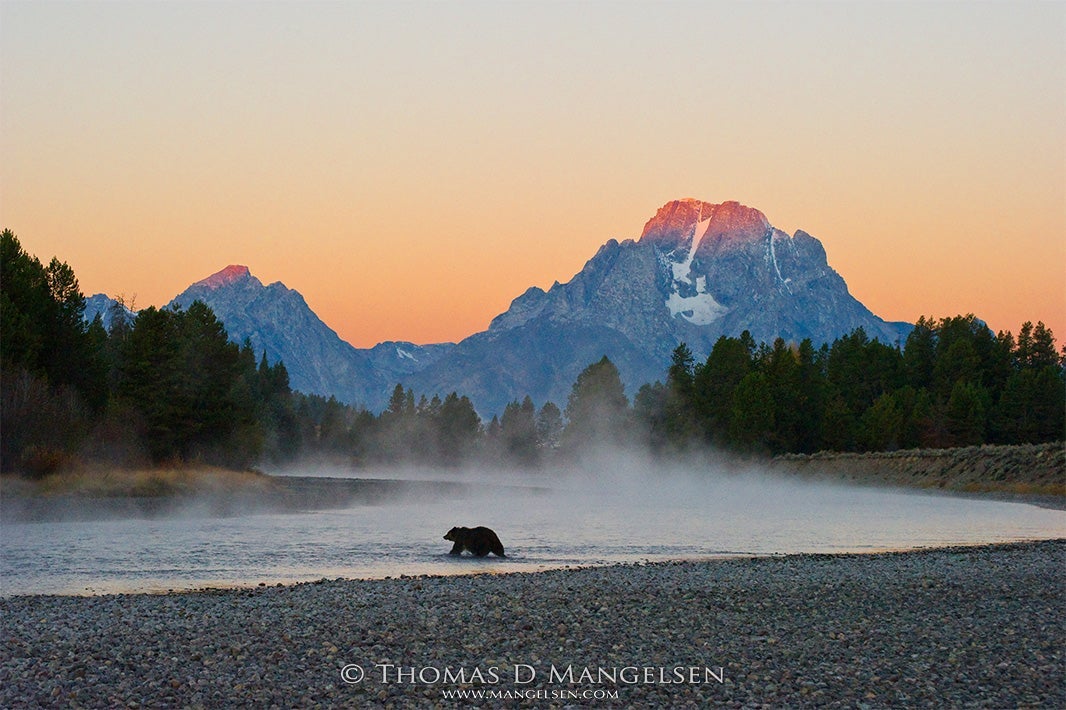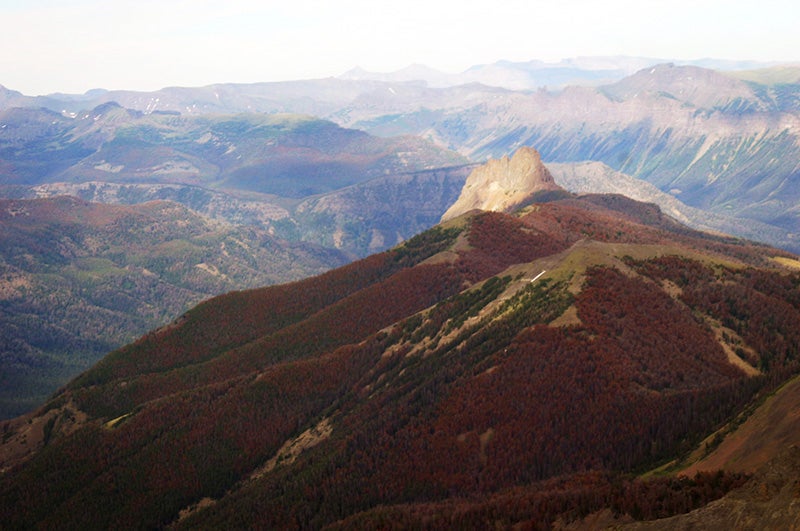October 23, 2024
“A Lens Into Their Lives”: The Grizzlies of the Greater Yellowstone Ecosystem
Grizzly 399, an iconic bear matriarch in the Greater Yellowstone region, has died due to a vehicle strike. Earthjustice has worked for decades to safeguard grizzlies from threats to their survival. Today we are mourning Grizzly 399’s loss and reflecting on these observations of her that legendary photographer Thomas D. Mangelsen shared in 2020. Read his statement on 399’s death.

For decades, Tom Mangelsen has traveled the world documenting disappearing wildlife.
But at his home in Jackson, Wyoming, he has witnessed the reverse: the return of an icon of the wild. The survival of the Yellowstone grizzlies owes to protections brought by the Endangered Species Act—and to efforts by the American public who have fought for years for the species to retain those needed protections.
Tom Mangelsen:
“Before sunrise one morning in 2006, my yellow lab Loup started barking frantically at the foot of my bed.
“I saw this bear standing face-to-face with my dog, with only the glass between them.
“I realized that it was a grizzly bear.”
“It was just staring as my dog was dancing around, being frantic.
“And then the bear just walked off into the darkness.”

“Later on, my assistant and I went up to try and see the bear and, sure enough, the bear was eating a moose carcass at the Oxbow Bend in Grand Teton National Park.
“It was almost dark. I took a few pictures and thought, ‘That was really cool. Grizzly bears are returning to Teton Park after 50 years or more.’
“I didn’t expect to see her again.”

“About a year later, I heard there was a grizzly with three yearlings near the Oxbow.
“Researchers had collared and tagged the bear as ‘399.’
“We started taking pictures of her and her cubs, and watching and learning more about her.”
“Grizzly 399 has given this gift of educating people that bears are incredibly beautiful animals.
“They take care of their young. They play. They nurse. They show emotions.
“This bear and her cubs have given us insight — a lens into their lives.”
“I’ve seen 399 and 610 — one of 399’s offspring — both lose their cubs and go absolutely crazy searching for them, frothing at the mouth and bawling, just like you would expect from a mother who loses her child at a Walmart.
“It’s that same kind of intelligence and emotions that these bears have.
“And we need to respect and honor that.”
A hunter claimed he poached and killed Grizzly 399 in the fall of 2015. After an agonizing wait, she emerged the following spring, safe and with a newborn, snow-faced cub by her side — her 16th descendant.
But if Endangered Species Act protections are removed, grizzly bears like 399 could be legally hunted once they cross over the invisible boundary lines of the park.
Earthjustice has worked for decades to safeguard the grizzlies from habitat destruction, excessive killing and other threats. The best available data indicates that their population has likely dipped in the last two years. The bears face the loss of two of its most important food sources — whitebark pine seeds and cutthroat trout — due to changing environmental conditions driven in part by our warming climate.
In the mid 2000s, the U.S. Fish & Wildlife Service began an effort to “delist” the grizzly from the Endangered Species Act, claiming the bears no longer needed protection. In doing so, the agency virtually ignored the threat posed by the dramatic die-off of whitebark pines.

But Earthjustice attorneys had been methodically documenting the decline of the trees and demonstrated the importance of this food source, using the government's own studies. The work successfully reoriented the legal argument to comport with biological facts.
The courts rejected that attempt to strip protections from the grizzlies, with the 9th Circuit Court of Appeals admonishing that “the Service cannot take a full-speed ahead, damn-the-torpedoes approach to delisting—especially given the [Endangered Species Act]’s ‘policy of institutionalized caution.’"
In 2017, the Fish & Wildlife Service again moved to remove federal protections for grizzly bears in the Yellowstone region, in defiance of the best available science. On Aug. 30, 2017, on behalf of Northern Cheyenne Tribe, Center for Biological Diversity, National Parks Conservation Association, and Sierra Club, Earthjustice filed a lawsuit in federal court to challenge the delisting decision. The legal challenge takes issue with the agency’s evaluation of the mortality consequences of the bears’ recent shift to a more heavily meat-based diet following the loss of other foods. It also faults the agency for surgically delisting the isolated Yellowstone grizzly population instead of focusing on a broader, more durable grizzly recovery in the West.
“With grizzly deaths spiking, now is not the time to declare the great bear recovered and federal protections unnecessary,” said Timothy Preso, managing attorney of Earthjustice's Northern Rockies Office. “We should not be taking a gamble with the grizzly’s future.”
Federal safeguards for Greater Yellowstone Ecosystem grizzly bears were reinstated in Sept. 2018, after Judge Dana L. Christensen of the Montana District Court ruled that the Trump administration’s decision to strip Endangered Species Act protections from the population was illegal. Earthjustice and our clients continued to defend the endangered species protections for the grizzlies.
Two years later, on Jul. 8, 2020, the Ninth Circuit Court of Appeals upheld the District Court's decision.
Tom Mangelsen:
“The people who come to our parks have a right to see these bears to enjoy them and to have their kids learn something about wildlife.
“There’s a level of savviness and intelligence in bears that is pretty remarkable.”
“Grizzlies can co-exist peacefully with people.
“But we have to be tolerant ourselves, just as they are tolerant.”

“I will continue to fight for the bears and for justice in the wildlife management system.
“We need more advocates for wildness and animals like 399.”
On May 5, 2020, Earthjustice attorney Tim Preso again defended Yellowstone's grizzlies in court, delivering arguments before the Ninth Circuit Court of Appeals. Two months later, the Ninth Circuit upheld the Montana District Court’s opinion, again sparing the grizzlies from plans for trophy hunts.
“This is a tremendous victory for those who care about Yellowstone and its grizzly bears,” said Preso. “The court rightfully rejected the misguided proposal to subject Yellowstone grizzlies to trophy hunting for the first time in 40 years. The grizzly is an icon of our remaining wildness at a time when our wilderness is shrinking and our wildlife is under assault.”
Environmental laws exist to protect our irreplaceable wildlife and wild places. But these laws mean little if they are not upheld. With hundreds of active legal cases, Earthjustice enforces laws to ensure that species and wild ecosystems can freely exist and adapt to a changing world. It’s an ongoing effort—and we are here for the long haul.
More on Grizzly 399
Grizzly 399's life story is a tale of the perils grizzlies face from humans — and the resilience that bears can demonstrate.
In 2016, Grizzly 399's snow-faced cub was killed in an apparent hit-and-run at night on the main road of Grand Teton National Park. Grizzly 399 refused to leave her cub's side, and it was some time before biologists could recover its body.
In her third decade of life and far beyond the age that bears typically bear young, many thought that cub would be her last. But on May 16, 2017, Grizzly 399 was spotted — with two rambunctious twins on the tow. And in the spring 2020, at an age when many thought she would no longer bear cubs, Grizzly 399 was sighted after winter hibernation with four thriving cubs.
“In nature there are no guarantees, and it’s not easy being a grizzly in the modern world,” said Mangelsen in an interview with National Geographic. “Every year that 399 has remained alive, raising successive broods of cubs, staying out of trouble with people, has been for those of us who enjoy her presence a gift and a miracle. You come to know her, respect her, value her as a mother teaching her cubs how to navigate a dangerous world.”
Acknowledgements
Special thanks to Thomas D. Mangelsen for the use of his photos and for his partnership in helping to secure a future for grizzly bears. Mangelsen has been observing and photographing the world's great wild places for more than four decades. Experience intimate portraits of Grizzly 399 in his book, Grizzlies of Pilgrim Creek, created in collaboration with writer Todd Wilkinson.
Established in 1993, Earthjustice's Northern Rockies Office, located in Bozeman, Mont., protects the region's irreplaceable natural resources by safeguarding sensitive wildlife species and their habitats and challenging harmful coal and industrial gas developments.
Established in 1989, Earthjustice's Policy & Legislation team works with champions in Congress to craft legislation that supports and extends our legal gains.